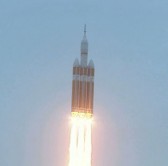 NASA took the first step Friday in what it hopes to be a new era for human space exploration as the agency sent the Orion capsule into a nearly four-hour orbit to evaluate its potential for future missions via Boeing‘s Space Launch System.
NASA took the first step Friday in what it hopes to be a new era for human space exploration as the agency sent the Orion capsule into a nearly four-hour orbit to evaluate its potential for future missions via Boeing‘s Space Launch System.
Engineers for NASA and Orion constructor Lockheed Martin focused much of their attention on the spacecraft’s heat shield and parachute system for re-entry, guidance and navigation technology and other components during Experimental Flight Test-1.
A Delta IV heavy rocket from United Launch Alliance, the 50-50 joint venture of Lockheed and Boeing, carried Orion into space in what was the 90th overall launch in ULA’s history and the 28th for Delta IV.
Click here to read ExecutiveGov’s recap of the technical details and next steps in the Orion program.

In an op-ed for CNN published on the morning of Orion’s launch, NASA Administrator Charles Bolden credited GovCon firms and other businesses for their roles in the space agency’s push to identify new ways of travel into low Earth orbit and eventually reach Mars.
“These commercial partnerships are proving that America works best when government and private-sector ingenuity work as a team,” Bolden wrote.
“Our commercial partners are not only allowing NASA to focus on our big goal of a human mission to Mars, they are also creating good jobs and strengthening our economy.”
Lockheed, the prime contractor for the Orion program, was selected in 2006 to build the spacecraft and help carry out testing and evaluation work on Orion.

The Friday test launch will give the team new data to work with before Orion’s next scheduled launch in late 2017 or in 2018, Lockheed’s lead space executive told the Denver Post.
“They’ll analyze the data here for weeks, looking for any changes they can make to the capsule going forward to make it a very safe environment,” said Rick Ambrose, president of Lockheed’s space systems company.
NASA and Lockheed enlisted some of the most recognized GovCon firms to help build components of Orion in the seven years between Lockheed’s initial contract award and the Friday test flight.
ATK built the inert launch abort motor and attitude control motor for the Orbital Sciences-made launch abort system and panels for the crew module’s exterior skin in order to protect the spacecraft from extreme temperatures in space.
Orbital designed the launch abort system to help future Orion crews escape from the spacecraft in case of an emergency either on the launch pad or at either low, medium or high-altitudes.
The launch abort system contains Honeywell avionics technologies for Orion’s onboard control of navigation and other flight functions.
ATK also constructed eight booster separation motors, three nozzles for the RS-68 engines built by Aerojet Rocketdyne, diaphragm propellant tanks and 12 composite structures for Orion.
“NASA and its partners have embarked on a new chapter of space exploration – one that will take humankind farther than we have ever ventured to go,” said Charlie Precourt, vice president and general manager of ATK’s space launch division and a retired Space Shuttle astronaut.
The RS-68 engines created 663,000 pounds of thrust to generate more than 17 million horsepower for the Delta IV heavy rocket’s launch, Aerojet Rocketdyne said.
Aerojet Rocketdyne’s RL10B-2 upper-stage engine provided 24,700 pounds of thrust to the spacecraft for insertion into orbit and the company’s jettison motor separated the launch abort system from Orion.
Steve Bouley, vice president of space launch systems at Aerojet Rocketdyne, said the engines worked in phases of “launching the Delta IV Heavy rocket off the pad, delivering the spacecraft to its destination, orienting the crew module properly throughout the mission, and then safely returning it to Earth.â€

Vencore — formerly known as The SI Organization — worked with the NASA-Lockheed team to prepare Orion for launch through the spacecraft’s testing and development phases.
Chantilly, Virginia-based Vencore, which acquired Qinetiq North America‘s services arm earlier this year, holds a prime contract for engineering services at NASA’s Kennedy Space Center in Florida.
“The Vencore workforce is part of a large, dedicated team that is committed to the continued success of our nation’s space exploration goals,” said Mac Curtis, Vencore’s CEO.
“We look forward to continuing our partnership with NASA and other aerospace companies in making those goals a reality.”
UTC Aerospace Systems — a unit of United Technologies Corp. — provided active thermal control, pressure control, power control and switching hardware for the Orion spacecraft.
The business also builds hydraulic power systems, power control and switching technologies, fluid sensing units and telemetry subsystems for the Delta IV vehicle’s common booster cores and upper stages.
“Results of this flight test will help inform the development of the crewed version of the Orion spacecraft, which our employees are already working on, for its first un-crewed exploration mission,” said Allen Flynt, general manager of human exploration and launch vehicles at UTC Aerospace Systems.
Airbus‘ space and defense unit will build the service module for Orion under an estimated $485.7 million contract with the European Space Agency, which plans to review the module’s design by November 2015.
The company will build the service module to give Orion propulsion, power supply, thermal control and life support system functions.





